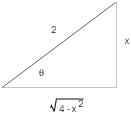
Trigonometric substitution ("trig substitution") reduces certain integrals to integrals of trig functions. The idea is to match the given integral against one of the following trig identities:

(a) If the integral contains an expression of the form ![]() , try a substitution based on the first identity:
, try a substitution based on the first identity:
![]() .
.
(b) If the integral contains an expression of the form ![]() , try a substitution based on the second identity:
, try a substitution based on the second identity:
![]() .
.
(c) If the integral contains an expression of the form ![]() , try a substitution based on the third identity:
, try a substitution based on the third identity:
![]() .
.
If you don't obtain one of the identities above after substituting, you've probably used the wrong substitution.
Example. Compute ![]() .
.
The expression "![]() " leads me to try
" leads me to try
![]()
Plug in:
![]()
![]()
![]()
![]()
To put the x back, I draw a right triangle. The substitution was
![]()
Since sine is the opposite side divided by the hypotenuse, I get:
![$$\hfil\raise0.5in\hbox{$\left[x = \sin \theta, \quad dx = \cos \theta\,d\theta\right]$} \hskip0.5in \hbox{\epsfysize=1in \epsffile{trig-substitution-1.eps}}\hfil$$](trig-substitution16.png)
I found the adjacent side ![]() using
Pythagoras. From the triangle, I see that
using
Pythagoras. From the triangle, I see that ![]() . Plugging this back in,
I get
. Plugging this back in,
I get
![]()
Example. Compute ![]() .
.
To "match" the "4" in "![]() ", I use
", I use ![]() (since
(since ![]() ). Differentiation gives
). Differentiation gives ![]() , so
, so ![]() . I plug in and simplify:
. I plug in and simplify:
![]()
![]()
![]()
I have an even power of cosine, so I need to use the double angle
formula for ![]() :
:
![]()
![]()
![]()
I need to put the x's back.
For the terms ![]() and
and ![]() , I need to express everything in
terms of trig functions of
, I need to express everything in
terms of trig functions of ![]() (as opposed to
(as opposed to ![]() or
or ![]() ). I use the double angle formulas for sine:
). I use the double angle formulas for sine:
![]()
Therefore,
![]()
The "![]() " in the first term is not inside a
trig function. For that term,
" in the first term is not inside a
trig function. For that term, ![]() gives
gives
![]() , so
, so ![]() .
.
For the second and third terms, draw a right triangle which shows the substitution.

The triangle shows ![]() --- the
opposite side is x and the hypotenuse is 2 --- and by Pythagoras the
third side is
--- the
opposite side is x and the hypotenuse is 2 --- and by Pythagoras the
third side is ![]() . Therefore,
. Therefore,
![]()
Plugging all of this into the last expression, I have
![]()
Example. Compute ![]() .
.
![]() looks like
looks like ![]() , so let
, so let ![]() . Then
. Then
![]() , so
, so
![]()
![$$\hfil\raise0.5in\hbox{$\left[x = 5 \tan \theta, \quad dx = 5 (\sec \theta)^2\,d\theta\right]$} \hskip0.5in \hbox{\epsfysize=1in \epsffile{trig-substitution-3.eps}}\hfil$$](trig-substitution55.png)
![]()
Example. Compute ![]() .
.
This could be done using ![]() . But it's easier
to do a u-substitution:
. But it's easier
to do a u-substitution:

![]()
Example. Compute ![]() .
.
![]() looks like
looks like ![]() , so
let
, so
let ![]() . Then
. Then ![]() , and
, and
![]()
![$$\hfil\raise0.5in\hbox{$\left[x = 2 \sec \theta, \quad dx = 2 \sec \theta \tan \theta\,d\theta\right]$} \hskip0.5in \hbox{\epsfysize=1in \epsffile{trig-substitution-4.eps}}\hfil$$](trig-substitution67.png)
![]()
![]()
![]()
Copyright 2019 by Bruce Ikenaga